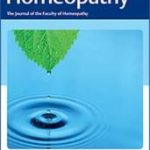Tim Jäger , Sandra Würtenberger, Stephan Baumgartner
Effects of Homeopathic Preparations of Mercurius corrosivus on the Growth Rate of Severely Mercury-Stressed Duckweed Lemna gibba L.
Homeopathy, 2019, 108 (2), 128-138

Background – We developed a bioassay with mercury-stressed duckweed (Lemna gibba L.) to study potential effects of homeopathically potentised mercury(II) chloride (Mercurius corrosivus [Merc-c.]). The response of this bioassay to homeopathic treatments as a function of stress intensity was also of interest.
Methods – Duckweed was severely stressed with mercury(II) chloride for 48 hours. Afterwards plants grew in either Merc-c. (seven different potency levels, 24x to 30x) or water controls (unsuccussed and succussed water) for 7 days. Growth rates of the frond (leaf) area were determined using a computerised image analysis system for different time intervals between the measurements on days 0, 3 and 7. Three independent experiments with potentised Merc-c. each were evaluated. Additionally, three water control experiments were analysed to investigate the stability of the experimental set-up (systematic negative control [SNC] experiments). All experiments were randomised and blinded.
Results – Unsuccussed and succussed water did not significantly differ in terms of duckweed growth rate. The SNC experiments did not yield any significant effects, providing evidence for the stability of the experimental system. Data from the two control groups and the seven treatment groups (Merc-c. 24x–30x) were each pooled to increase the statistical power. Duckweed growth rates for day 0 to 3 were reduced (p < 0.05) after application of Merc-c. compared with the controls. Growth rates for day 3 to 7 were not influenced by the homeopathic preparations.
Conclusions – The present test system with Lemna gibba L. that was severely stressed by mercury yielded evidence for specific effects of Merc-c. 24x to 30x, namely a growth reduction in the first time period (day 0–3). This is in contrast to former experiments with slightly arsenic-stressed duckweed, where a growth increase was observed in the second time period (day 2–6). We hypothesise that the differing results are associated with the level of stress intensity (severe versus slight).






Lascia un commento
Devi essere connesso per inviare un commento.